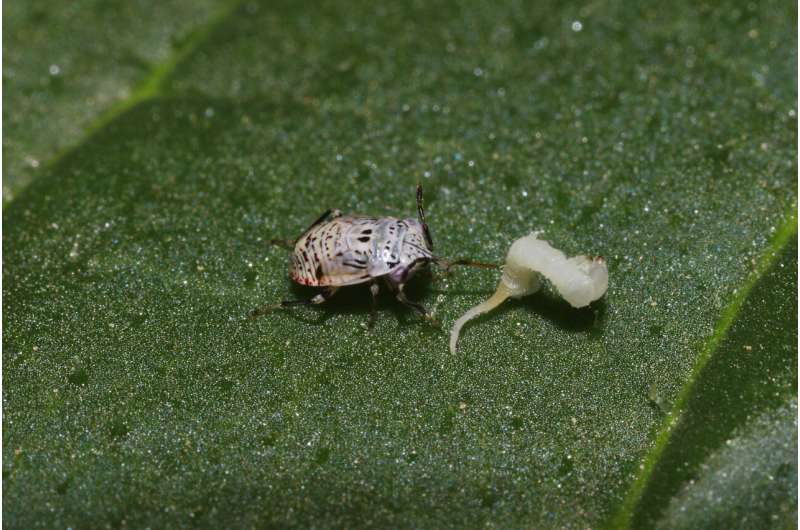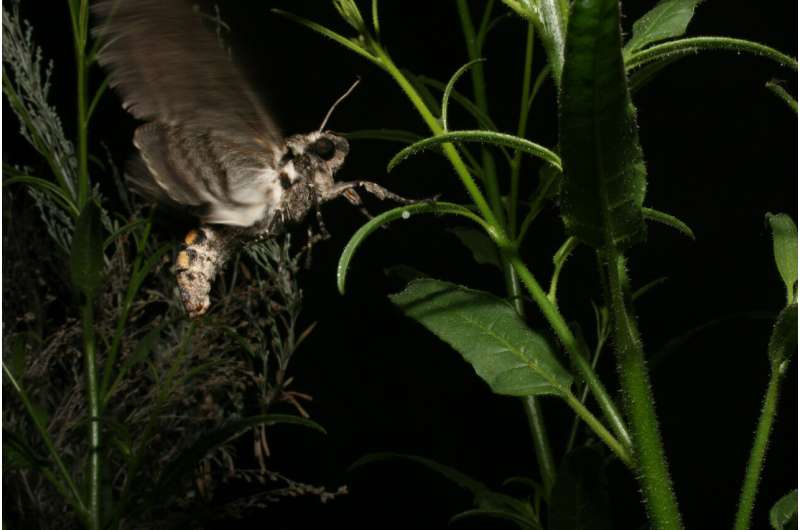The chemical language of plants depends on context

A team of scientists from the Max Planck Institute for Chemical Ecology in Jena, Germany, studied the ecological function of linalool, a naturally abundant volatile organic compound, in wild Nicotiana attenuata tobacco plants. They found the gene responsible for linalool synthesis and release which vary considerably in plants of the same species. Females of the tobacco hawkmoth (Manduca sexta) prefer to lay eggs on plants with a higher naturally occurring linalool. At the same time, the more linalool a plant released, the more eggs and freshly hatched larvae were predated on by bugs. Behavioral assays in increasingly complex environments showed that the effects of linalool are quite variable, depending on the natural environment and the genetic makeup of the plant. The study is published in the Proceedings of the National Academy of Sciences.
Interactions between tobacco plants, tobacco hawkmoths, and predatory bugs
Plants have evolved multiple strategies to defend themselves against herbivorous animals, especially insects. In addition to mechanical defenses, such as thorns and spines, plants also produce chemical defense compounds that hold insects and other herbivores at bay. These substances include volatile organic compounds, often only produced by plants after insect attack. Linalool is such a plant volatile organic compound; it mediates different ecological interactions with insects.
Its complex mode of action has already been the subject of previous investigations. It is known that linalool in tobacco plants can attract predatory Geocoris bugs to show them the way to their prey: the eggs or freshly hatched larvae of tobacco hawkmoths. However, as a floral scent component, linalool is also attractive for adult hawkmoths and influences mated female moths in their decision to lay their eggs on a plant. A team of scientists from the Max Planck Institute for Chemical Ecology lead by Meredith Schuman and Ian Baldwin has now studied the ecological functions of the monoterpene linalool in wild Nicotiana attenuata plants in more detail.
The genetic analysis of linalool synthesis
The researchers observed a correlation between the rate of Manduca sexta eggs predated by Geocoris bugs and the amount of linalool produced by the respective plants. They didn't observe such a correlation between five similar organic compounds emitted by tobacco plants and the egg predation rate. This indicates that linalool, in fact, functions as the plants' chemical cry for help and attracts predatory bugs that attack herbivorous larvae. "Tobacco plants vary a lot in their linalool emission. If linalool mainly has a defensive effect, that is attracting predators and repelling hawkmoths, we would expect there to be less variation. Obviously, linalool emission is not always advantageous for the plant. Therefore we wanted to explore systematically, which ecological interactions result from differences in linalool production," Jun He, the first author of the study, explains.
The scientists were able to identify the enzyme that regulates linalool synthesis in Nicotiana attenuata and to determine its genetic basis. To achieve this, they crossed plants from native populations in Arizona which were high in linalool production, with plants from Utah which produced considerably less linalool. This approach, which is called forward genetics, allowed for an identification of genes underlying the natural variation of linalool synthesis.
Mirror images of molecules and their different effects

Linalool occurs in two different forms, so called enantiomers. Both enantiomers, (R)-(?)-linalool and (S)-(+)-linalool, are almost identical, however, their three-dimensional structures are mirror images of each other. Although only (S)-(+)-linalool was found in natural Nicotiana attenuata populations in Utah and Arizona, the researchers also used plants in their experiments which produced its mirror image, (R)-(?)-linalool. Both enantiomers are perceived as two different compounds by hawkmoths, resulting in different effects on their behavior.
The scientists tested the effect of these plants in behavioral assays with tobacco hawkmoths. They observed the behavior of mated females exposed to two different experimental plants in a choice assay in a wind tunnel in order to answer the question how linalool blends affect oviposition. Amazingly, egg-laying was only partially influenced by a manipulated production of the two linalool enantiomers. In fact, the genetic background of the plants, that is, whether a Utah or an Arizona plant had been modified to produce more linalool, had a much higher impact on the moths' preferences. "It was surprising to us that experimental context mattered even more than the two different enantiomers," Richard Fandino, who designed the wind tunnel experiments, explains. The researchers performed further experiments with moths and different tobacco plants in oviposition chambers and a large experimental tent, where moths were able to fly around. However, the differences in the moths' responses to linalool emission vanished, the more complex the environment became.
The meaning of signals in context
Context is a linguistic term. It points to the problem that words or vocabulary may have different meanings depending on the communication situation in which they are used. This is also true for the "chemical vocabulary" component, linalool. Originally, the authors of the study expected that a chemical compound triggers a certain behavior. "However, our study showed that moths pay attention to many different features of plants when choosing where to feed or oviposit. Then, they integrate this information in order to choose among the available plants. Thus, differences in other plant properties as well as the availability of alternative plants and their characteristics, are likely to determine the importance of any individual cue: in this case, linalool," Meredith Schuman, one of the main authors of the publication, summarizes.
A better understanding of context-appropriate plant defense against herbivores might help to overcome problems in standardized industrial agriculture, such as the evolution of resistance to commonly used pesticides.
More information: Jun He el al., An unbiased approach elucidates variation in (S)-(+)-linalool, a context-specific mediator of a tri-trophic interaction in wild tobacco, PNAS (2019). www.pnas.org/cgi/doi/10.1073/pnas.1818585116
Journal information: Proceedings of the National Academy of Sciences
Provided by Max Planck Society

















